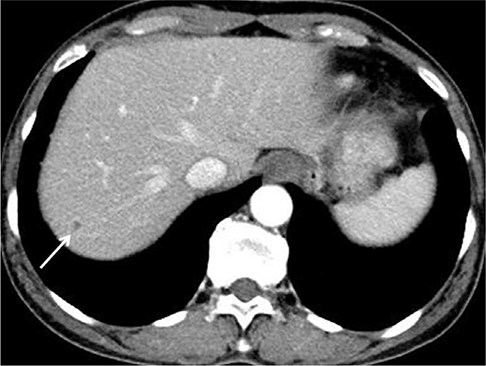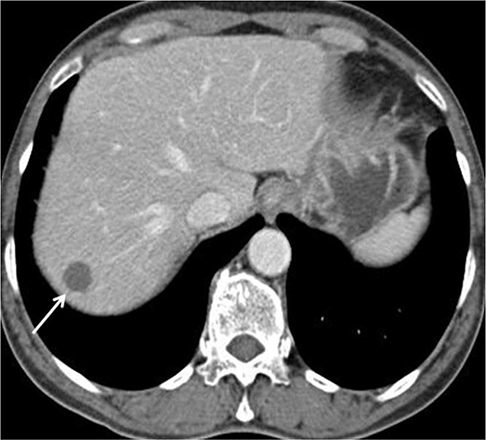Investig Magn Reson Imaging.
2018 Jun;22(2):113-118. 10.13104/imri.2018.22.2.113.
Hepatic Toxocariasis with Atypical CT and MR Imaging Findings: a Case Report
- Affiliations
-
- 1Department of Radiology, Chungnam National University Hospital, Chungnam National University School of Medicine, Daejeon, Korea. shinks@cnu.ac.kr
- KMID: 2415890
- DOI: http://doi.org/10.13104/imri.2018.22.2.113
Abstract
- Hepatic toxocariasis is a type of visceral larva migrans caused by the migration of second-stage larvae of certain nematodes such as Toxocara canis to the liver. Histologically, the condition is characterized by granulomatous lesions containing eosinophils and inflammatory cells. We report a case of hepatic toxocariasis with atypical clinical and radiologic findings presenting as distinct, solitary hepatic nodule detected in a middle-aged woman.
MeSH Terms
Figure
Reference
-
1. Mukund A, Arora A, Patidar Y, et al. Eosinophilic abscesses: a new facet of hepatic visceral larva migrans. Abdom Imaging. 2013; 38:774–777.
Article2. Lim JH. Toxocariasis of the liver: visceral larva migrans. Abdom Imaging. 2008; 33:151–156.
Article3. Ishibashi H, Shimamura R, Hirata Y, Kudo J, Onizuka H. Hepatic granuloma in toxocaral infection: role of ultrasonography in hypereosinophilia. J Clin Ultrasound. 1992; 20:204–210.
Article4. Chang S, Lim JH, Choi D, et al. Hepatic visceral larva migrans of Toxocara canis: CT and sonographic findings. AJR Am J Roentgenol. 2006; 187:W622–W629.5. Dupas B, Barrier J, Barre P. Detection of Toxocara by computed tomography. Br J Radiol. 1986; 59:518–519.6. Arango CA. Visceral larva migrans and the hypereosinophilia syndrome. South Med J. 1998; 91:882–883.
Article7. Bhatia V, Batra Y, Acharya SK. Prophylactic phenytoin does not improve cerebral edema or survival in acute liver failure--a controlled clinical trial. J Hepatol. 2004; 41:89–96.
Article8. Hayashi K, Tahara H, Yamashita K, et al. Hepatic imaging studies on patients with visceral larva migrans due to probable Ascaris suum infection. Abdom Imaging. 1999; 24:465–469.
Article9. Laroia ST, Rastogi A, Sarin S. Case series of visceral larva migrans in the liver: CT and MRI findings. Int J Case Rep Imag. 2012; 3:7–12.
Article10. Azuma K, Yashiro N, Kinoshita T, Yoshigi J, Ihara N. Hepatic involvement of visceral larva migrans due to Toxocara canis: a case report--CT and MR findings. Radiat Med. 2002; 20:89–92.
- Full Text Links
- Actions
-
Cited
- CITED
-
- Close
- Share
- Similar articles
-
- Atypical Hepatic Angiomyolipoma: CT and MR Findings: A Case Report
- Pulmonary and Hepatic Involvement of Toxocariasis in an Adult: Case Report
- Liver Neoplasms: Atypical CT and MR Imaging Findings
- Hepatic Cavernous Hemangioma in Cirrhotic Liver: Imaging Findings
- Ultrasound, CT, and MR imaging Findings of Paraganglioma Originating at the Urinary Bladder: A Case Report







